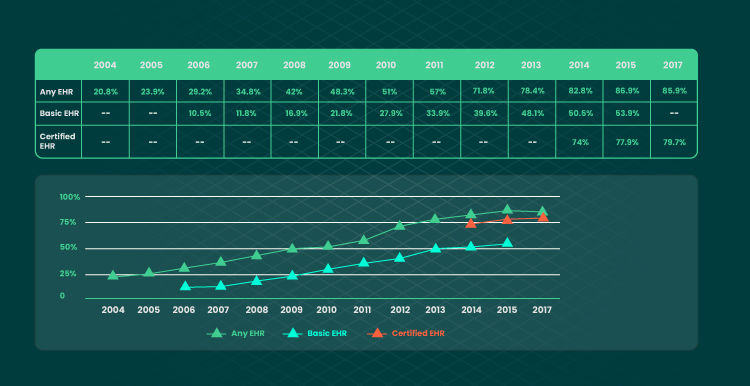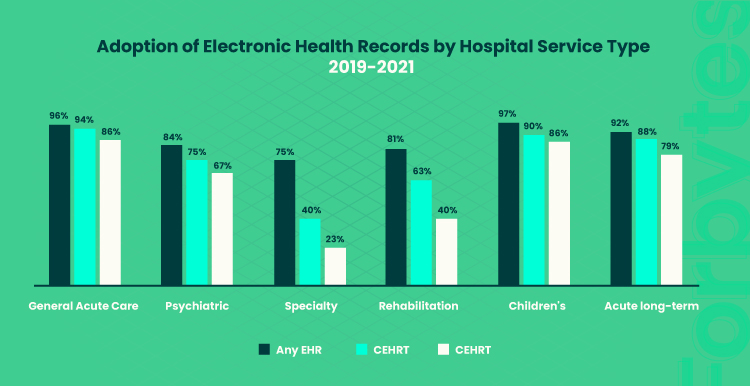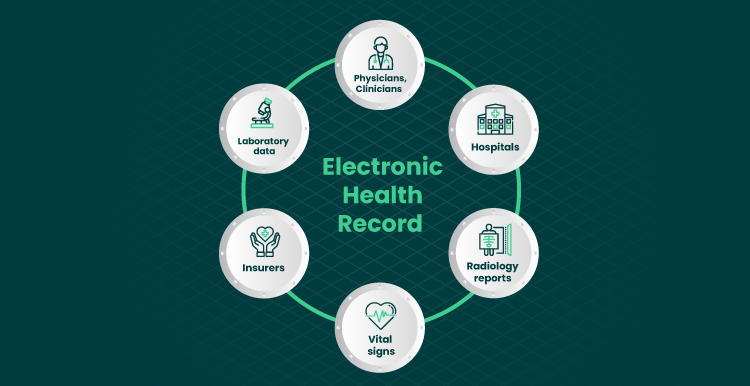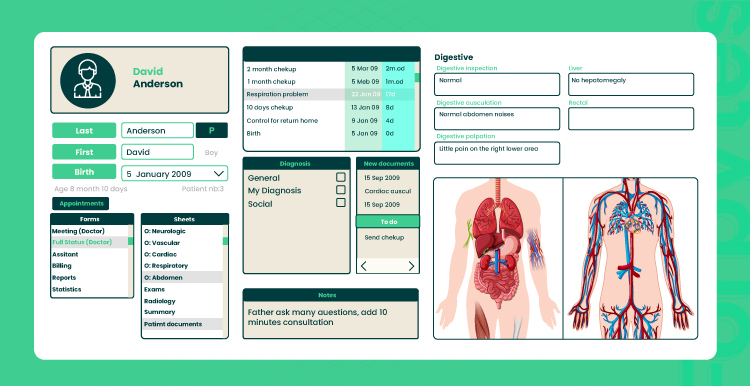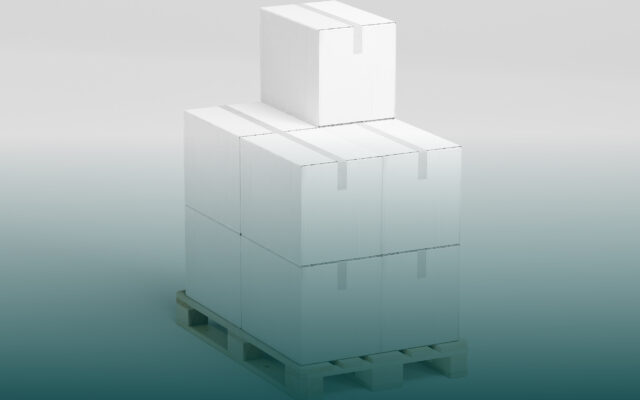Implementing electronic records in medical practice drives industry renovation and growth. In 2019-2021, 86% of non-federal healthcare organizations adopted the electronic health record for daily practice. Medicaid EHR incentive programs help healthcare facilities digitize their workflow. They can also streamline patient-employee interaction. Cross-team communication is facilitated by real-time data sharing. This is what healthcare organizations value when it comes to digital solutions.
In this post, we’ll talk about cloud-based EHR and how it differs from EMR and paper records. We’ll also share our view of how to build a user-friendly EHR solution and what features to integrate.
What Is EHR?
EHR stands for Electronic Health Record. This is a real-time digital version of patient’s medical history. This solution stores data related to patient care. This, for example, includes info on patient demographics, doctor’s notes, patient complaints and vital signs of disease, diagnostic reports, past medical history and progress notes, and more. The electronic health record (EHR) is patient-centered. It’s used to quickly access and manage vital patient information and streamline patient care. Also, it’s used to facilitate the in-house workflow, management, and employee interaction within a system. With electronic records, medical providers can easily embed evidence-based tools and practices. As a result, they can maintain a high quality of treatment.
Technologies are penetrating nearly all industries in which patients and medical representatives operate. The medical sphere cannot lag behind. It’s now inefficient to use paper medical records when almost every sphere of life is digitized. This is why facilities rely on the power of technology to provide a seamless patient experience and the ease of practice management.
How can electronic health records affect patients? The answer is simple:
- Reduce medical errors and prevent data loss. Manual data management leads to medical errors. By using EHR, patients’ care providers eliminate the risks of misinterpreted diagnostic results. EHR tools secure patient data, reduce medical errors, and prevent data loss.
- A holistic picture of the patient’s condition. With electronic medical record software, all data is available in one system. Data on patient lifestyle, demographics, diet, allergies, and test results can be essential for choosing the right treatment and providing quality care.
- Information availability in real-time. This allows health care providers to access the patient record regardless of other authorized providers. If the situation requires so, doctors can consult with each other without leaving their workplace. This brings innovation and growth to the healthcare settings in general.
- Time efficiency. A patient doesn’t have to wait for a doctor to look for the patient’s medical record folder on the overloaded shelves. Medical providers access everything needed in a few clicks. What’s more, standardized questionnaires allow them to streamline communication with patients and not miss anything vital to recovery.
Electronic health records can be:
- Locally hosted. Locally hosted EHR are running on local servers that do not go beyond the limits of one healthcare organization. To access a locally hosted EHR system, office-based physicians do not need an Internet connection. Personal health records are stored within their organization.
- Cloud-based. Cloud-based or web-based EHR is built by a third-party vendor using the cloud. Such a solution can be accessed by many users at the same time. Updates to data are introduced in real-time so that everyone’s on the same page when analyzing the patient record. This is a cloud provider that ensures that your solution functions well. So, you get rid of the headache of maintaining a quality solution.
EHR vs. Paper-Based Records
Electronic health record: This is a time-efficient solution that automates the interaction with a patient and helps to get all the data essential for recovery. Implementing cloud-based EHR is also a way to become more eco-friendly. You will use less paper if you choose to keep and manage data in digital form. As a bonus, you prevent human errors and increase the accuracy of medical interpretations.
Paper-based records: Managing paper-based records takes time. Instead of deeply analyzing a patient case, clinicians need to look for a particular record manually. Then, they fill in all the data and put it back for other providers to access it hereafter. Meanwhile, conventional record management is more secure than electronic one. When using an EHR, a patient is responsible for data protection from third-party access. Password disclosure or the neglect of security measures may result in system breaches. This, in turn, leads to significant financial losses for healthcare vendors.
EHR vs. EMR
EHR: Electronic health record. This is a digital record of the patient’s health. It was created to streamline the cooperation between medical specialists. Cloud-based EHR is shared across departments and medical facilities. Doctors, clinicians, laboratories, pharmacies, and other health care providers can access medical data from the EHR system to get a holistic picture of patient conditions.
EMR: Electronic medical record. It’s a personal digital chart of a patient that is stored in the hospital’s database. The difference between EHR and EMR lies in the fact that the latter offers a narrower look at the patient’s condition. Electronic medical records usually contain information for one-time practice. For example, medication prescriptions, diagnoses, test results, or more. They do not consider extra factors that shape patient health. Electronic medical record systems are created for each patient. They’re used to document the patient’s current state, medication strategy, immunization dates, and so on. Also, EMRs are not designed to be shared with other medical specialists. Usually, these are customized medical portfolios with profiles for each patient.
EHR Benefits
EHR gives plenty of benefits for both patients and clinicians involved in treatment.
To grasp the prospects electronic record management can give you, check some of them below:
- Evidence-based approach. Electronic health records open the way to data-driven decision-making in medicine. Human health highly depends on the factors that shape our everyday lives. The more data a clinician has at hand, the more effective decisions they can make and the more they contribute to patient safety.
- Data integrity. All the data on patient health is stored and managed under one roof. This saves time for both patients and doctors. No one is supposed to wait till their paper-based record is found and brought to a doctor. Data on test results, medical imaging results, medications, patient mental health state, etc., are included in the record.
- No data replication. Storing tons of handwritten personal health record files is inefficient in terms of time, ecology, and costs. What’s more, the paper-based approach does not allow you to access everything needed in one place. This leads to data replication, as multiple facilities may store the same medical records in different places. With powerful EHR development, you eliminate the risks of data replication. A standardized approach to collecting data allows specialists to get rid of data duplicates or gaps.
- Improved compliance. EHR cloud-based solutions are built in compliance with different regulations and laws. They are data-driven and aim to bring tech innovation to the medical sector. Besides, data in EHR serves as a checklist for clinicians who manage patient records. All they need to do to get a complete picture of a patient’s condition is to access the data that is already available and fill in the data gaps by questioning the patient.
- Enhanced management. Clinicians get automated notifications when it’s time for a patient to schedule a hospital visit. They can manage their schedule and let clients manage appointments in EHR systems. Doctors are also notified when diagnostics or scanning results are added to the system by other facilities. This helps healthcare providers detect and fight diseases at the early stages.
- Better care coordination. According to the holistic approach, the human body is viewed as a whole. By implementing EHR, your employees get access to valuable evidence of effective treatment strategies. They can serve as clinical guidelines and resources with useful health information for the whole medical team. Evidence-based practices lead to better patient outcomes and a more facilitated recovery process.
- Fresh ideas and growth. AI-powered data analytics tools are capable of analyzing large volumes of structured and unstructured data. The visualization of AI-based interpretations can help medical employees detect patterns in patient conditions, prevent or reduce risks, and extract insights into the current region. For instance, the rise of patient complaints may point to the spread of seasonal influenza or infection. When doctors detect such patterns, they get the chance to offer preventive services. They can also protect high-risk patients from severe hazards.
- Connectivity and support. You can use EHR cyberspace to send messages to clients, notify them about important events, share useful resources with them, and more. By using an EHR system, you let a patient know that the medical side of their life is in safe hands. Electronic health record systems add comfort and ensure 24/7 access to essential data for a patient.
How to Build an EHR System? 10 Steps to Mind
- Assess your capabilities. Building a custom EHR system or purchasing an on-premise solution is a costly investment. Make sure that your company can afford to implement web-based EHR. Your employees need to clearly understand the benefits they will get with EHR software. Otherwise, you’ll be at risk of building a solution no one is interested in.
- Think about our essential functions. Below, we’ve compiled a list of top features to be added to EHR software. But you can use it as a basis and complement your own list based on your team’s insights. Together with your team, brainstorm ideas for the useful functions that you want to see in the software. Go through competitors to get deep into the topic.
- Create an implementation roadmap. Define the time frame for project implementation. Involve all stakeholders who may be interested in such a solution in the discussion. Make sure they know what goals you pursue and what expectations you have for this piece of software.
- Choose or build an EHR. On-premises solutions need to have the most critical functions for your business. If you can’t find an option worth your money, choose custom EHR software development. By choosing this, you’ll get full control over the software and can scale the project up or down anytime.
- Don’t forget about mobile. Having a web-based application for electronic health record management is a great idea. And building a mobile-friendly solution is even better. The thing is, by optimizing your software for mobile, you increase the number of people using your software. Data management becomes portable. All patients need to access their personal info is to get their phones out of their pockets and type the right address in.
- Check compliance. Make sure that your solution is GDPR-compliant. This is a set of regulations active in the EU for third-party data processing. If your solution collects and processes patient data, you need to ensure a high level of security. Also, if you target the US market, you need to comply with HIPAA (Health Insurance Portability and Accountability Act). The document covers all the issues related to health data processing, including the technical ones. To avoid fines and prove the trustworthiness of your software, you will have to undergo certification. In the EU, it will be EuroRec certification. In the US, you’ll undergo ONC-ATCB Certification. These are required to document that your piece of software is compliant with healthcare regulations and standards such as CCA, CCD, CCR, and more. IT consultation on EHR software development can help you make your solution compliant and secure.
- Implement data integrity. EHR cloud is performant and capable of processing large volumes of data. Make use of this function and ensure 100% data integrity. For user convenience, provide data synchronization opportunities. For example, synchronizing data with Apple Health Records will give primary care physicians a better understanding of patients’ life habits and health data collected outside your organization.
- Provide your employees with hardware. Conduct an audit of your organization’s hardware. To ensure that your cloud-based EHR will be used by a wide audience, make a solution compatible with a range of devices. Your electronic health record (EHR) should work well on laptops, computers, all-in-one computers, different mobile devices, etc. If you lack the hardware essential for digital transformation, you’ll need to invest in hardware, too. For you to cultivate tech-based medical practices, your team has to be surrounded by technology ready to serve their needs.
- Train your employees. Prepare training programs before full-scale implementation of an EHR system. Healthcare providers should feel comfortable using your digital product. Role-based training programs developed in advance have to demonstrate all the benefits the health information technology will offer. Ongoing support provided for your team and patients will give them guidelines at the early implementation stages.
- Test and improve your software. Agile software product development provides healthcare organizations with quality assurance and ongoing support. Gather the feedback after the implementation of your cloud-based EHR. The user satisfaction rate is an informative metric that you can consider when improving your software. This will help you find the functionality loopholes and weaknesses to be eliminated.
Important Features for EHR System
The list of features to be built depends on the specifics of your business, the country you focus on, users’ digital habits, and more. Namely, emergency facilities will need a different functionality than the average school and workplace clinics. But there’s a list of common functions that will give you some ideas on what to integrate into your web-based EHR system. It’s better to start with basic functionality and add new features as far as healthcare professionals need them.
Data request function
Facilities will use this function to request data from each other. Clinicians can request data from laboratories or colleagues to get a complete picture of patient health. Cross-team functional cooperation will enhance patient recovery and streamline the workflow.
Schedule and task management
Patients need to have the opportunity to schedule appointments in EHR systems. Also, schedule management can be used by employees to organize work time and distribute patient queues effectively. Tasks to do, in progress, and completed will be reviewed by the staff to increase productivity and efficiency.
Database management
Cloud-based EHR vendors give unlimited data management opportunities. Secure data storage enables healthcare providers to access the needed file in a few clicks. The database supports different file formats like documents, radiology images, and other media files.
Care tracking
This function will be used for tracking the process of patient recovery. It may be subdivided into multiple sections, including those with prescription data, drug interactions, clinical data, health metrics tracking, and the analysis of patient health outcomes.
User Profile
One of the main functions a good EHR solution should have. A user profile includes essential patient information. This includes their name, surname, age, test results, disease description, treatment, and medical history, and more. The doctor dashboard can provide deeper access to the patient profile and include more functionality on treatment planning.
Notifications
Doctors will receive critical alerts on drug interventions or changes in vital health metrics. This practice is adopted by many healthcare organizations. Apple Health services, for example, offer the function of notifying family members if the heart metrics of a user change rapidly and pose a threat to user’s health. Also, users will get reminders on upcoming events and appointments. It will also be convenient for them to get notifications on drug intake time. Adopt such a function — and you’ll get higher patient satisfaction in return.
Data analytics
AI-powered data analytics is a useful function for large-scale health care informatics. Data charts enable clinicians to detect patterns and tendencies and improve patient outcomes as well as workflow. Having statistical data in the form of a patient’s chart enables healthcare facilities to target their effort at the right aspects and find new growth opportunities.
Chat function
Quick chats with colleagues or patients are a good way to save time and get the needed answers to small issues promptly. To ensure flawless client service 24/7, you can integrate smart chatbots that will streamline planning, organize appointments, and answer patient questions when clinicians are unavailable.
User portals
A patient portal is regularly updated with news and useful information for patients or staff. Building a space where people can learn something new will expand the audience and educate patients on their health.
Distributed Access Control
Distributed access control means that authorized users have different levels of access to patient information. Obviously, managers need other information at hand compared to clinicians or nurses. Similarly, doctors have access to the data on all their patients, while patients can access their own health information only. This helps ensure the security of sensitive patient data and the confidentiality of healthcare services.
Cloud hosting
Physical data storage of patient records is prone to data security risks. Cloud hosting, in turn, is a safe and scalable solution for data management. It’s location-independent, so system users can access patient information no matter the time and place.
Are You Wondering About Building an EHR System?
This article is a deep dive into the discussion of EHR. A performant and secure EHR can give your organization a boost in terms of profitability and performance. Convenience and efficiency offered to users will translate into a good market reputation and client recognition.
If you plan to build an EHR system as a startup or in-house solution, you’ll need the help of experienced software product engineers. Forbytes has more than 10 years in the software solution market and can help you implement a consistent plan for your project. Together, we’ll create a solution your employees and patients will appreciate using. Thanks to such innovations as integrating EHR systems, the health care system will grow and digitize, offering more value to all stakeholders.

Our Engineers
Can Help
Are you ready to discover all benefits of running a business in the digital era?

Our Engineers
Can Help
Are you ready to discover all benefits of running a business in the digital era?


